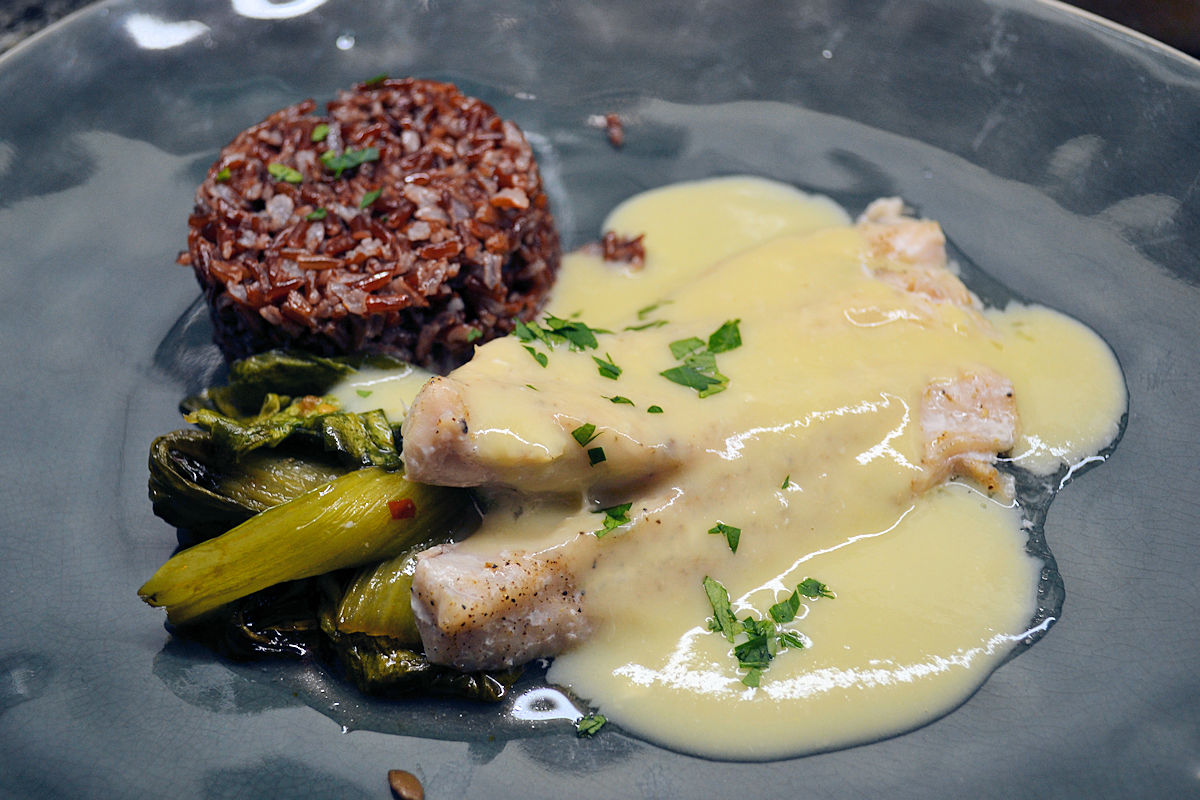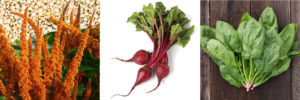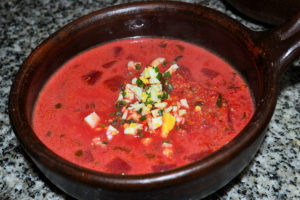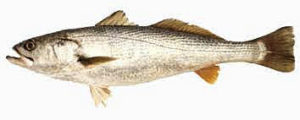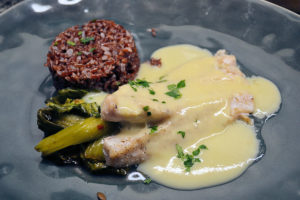Menu #40
September 20-22 – 2018 – 20-22 de Septiembre
Plates of the week / Platos de la semana
Here’s something I’ll bet most of you didn’t know. Quinua, beets, spinach (and chard as well) are all part of the same happy family of plants. As such, this recipe is sort of a family reunion!
Acá hay algo que apuesto que la mayoría de ustedes no sabía. Quinua, remolacha, espinaca (y acelga también) son parte de la misma familia feliz de plantas. Como tal, esta receta es un tipo de reunión familiar!
A chupe is a sort of chowder with origins in southern Peru. There are numerous types, and home cooks pride themselves on the variety of chupes that they can prepare, particularly in and around the city of Arequipa. This chupe brings together three related, but different, plants, and more specifically, parts of those plants – seeds, roots, and leaves.
To make this soup, I saute chopped garlic and rocoto chili in oil, then add cumin and white pepper. Separately, I rinse and then partially cook some quinua, and in another pot, some peeled and diced beets, both in salted water. I drain them, add both to the pot with the garlic, and cover them with water. Continue cooking until both the quinua and beets are soft. Then stir in some crumbled fresh cheese, a splash of cream, and finish with chopped spinach. To serve, we top it with chopped hard boiled eggs and chives.
Un chupe es un tipo de sopa con orígenes en el sur de Perú. Existen numerosos tipos, y los cocineros domésticos se enorgullecen de la variedad de chupes que pueden preparar, particularmente en los alrededores de la ciudad de Arequipa. Este chupe reúne tres plantas relacionadas, pero diferentes, y más específicamente, partes de esas plantas: semillas, raíces y hojas.
Para hacer esta sopa, salteo el ajo picado y el rocoto en aceite, luego agrego el comino y la pimienta blanca. Por separado, enjuago y luego parcialmente cocino algo de quinua, y en otra olla, algunas remolachas peladas y cortadas en cubos, ambas en agua con sal. Los colaboro, agrego ambos a la olla con el ajo y los cubro con agua. Continúe cocinando hasta que ambos la quinua y la remolacha estén blandas. Luego agregue un poco de queso fresco derretido, un chorrito de crema y termine con espinacas picadas. Para servir, lo adornamos con huevos duros picados y ciboulette.
This is a weakfish, here in Argentina called a pescadilla.
Este es un pez que acá en Argentina se llama pescadilla.
I love garlic, and one of my favorite Peruvian sauces is the ajillo. Though, for me, the Peruvians never put enough garlic in it. It’s that Italian cooking background coming into play. This is a simple dish to prepare, but the flavor impact is impressive. The four components of it are rice – here I used a red rice, which is a nutty, slightly chewy, whole grain rice, and it’s cooked simply in salted water. Bok choy, separated into leaves and rubbed with chili-garlic paste, left to sit for a couple of hours and then cooked in the oven, turning regularly. The fish, filleted, then dusted with cumin, black pepper, and salt, a little oil, and broiled. And, the sauce – I puree a whole head of garlic in two cups of fish stock, strain it, then add two eggs, two tablespoons of flour, and the juice of two lemons. I heat it slowly, whisking regularly, letting the garlic poach and the sauce thicken, then season with salt and white pepper. It’s not the traditional way to make ajillo sauce, but it’s so good!
Me encanta el ajo, y una de mis salsas peruanas favoritas es el ajillo. Aunque, para mí, los peruanos nunca le ponen suficiente ajo. Es ese fondo de cocina italiana entrando en juego. Este es un plato simple para preparar, pero el impacto del sabor es impresionante. Sus cuatro componentes son el arroz, acá utilicé un arroz rojo, que es un arroz integrál, con sabor a nuéz y ligeramente correoso, y se cocina simplemente en agua con sal. Bok choy, se separó en hojas y se frotó con pasta de ají y ajo, se dejó reposar durante un par de horas y luego se cocinó en el horno, volteando con regularidad. El pescado, fileteado, luego espolvoreado con comino, pimienta negra y sal, un poco de aceite y cocido abajo del asadora. Y, la salsa: puré una cabeza entera de ajo en dos tazas de caldo de pescado, lo colaboré y luego agregué dos huevos, dos cucharas soperas de harina y el jugo de dos limones. Lo caliento lentamente, batiendo regularmente, dejando que el ajo se pochá y la salsa espese, luego sazone con sal y pimienta blanca. No es la forma tradicional de hacer salsa al ajillo, pero es tan bueno!
